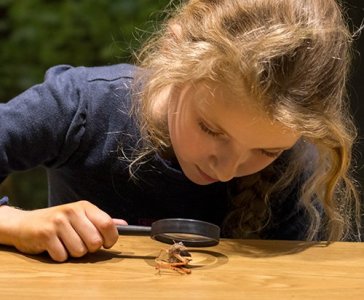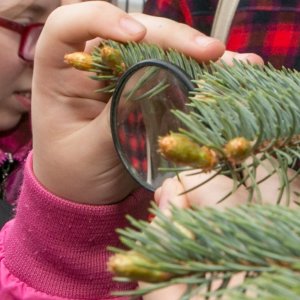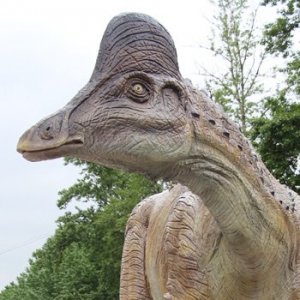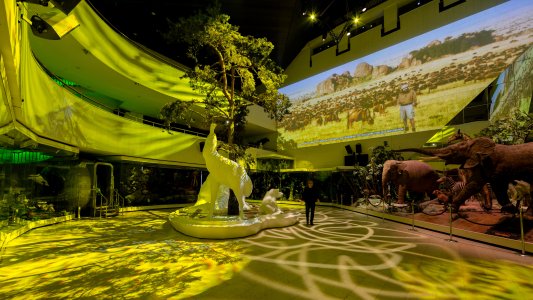
ANNUAL PUBLIC FESTIVALS
Each year the State Darwin Museum in Moscow holds a number of various environmental public festivals for visitors of different age: International Bird Day,Ecologist’s Day,Evolution Day,World Water Day,Wood-goblin’s Day,International Earth Day,World Animal Day and others.The celebration usually includes such educational, creative and cultural activities as contests, quests, master-classes, concerts, scientific experiments and classes in laboratories.

AR-QUEST "LIFE CODE"
State Darwin Museum is inviting you to complete the "Life Code" AR-quest - one of the first AR quests in the world as well as the biggest museum quest in Russia! The quest is free for all museum visitors and is available for Android and iOS, including online format. According to the story line of the game, the action takes place in 2057 (the year of the 150th anniversary of the State Darwin Museum), when humanity is very close to decoding the genome of all living things on Earth. To collect the missing data, you are sent to Darwin Museum, where DNA samples of rare and extinct animal species are stored. You will have to complete tasks given by a personal assistant - artificial intelligence robot MAX-2057, as well as solve puzzles and look for "keys" and clues hidden among the museum's exhibits. In order to find the "Life Code", you will need to interact with real museum exhibits in AR mode - in total, more than 30 modern and extinct animals participate in the quest, from the ocean sunfish to the Velociraptor. About the project:The "Life Code" quest is the first stage of cooperation within the framework of the Memorandum of understanding between the State Darwin Museum and Microsoft in Russia. The AR-quest was created in partnership with Next.space, which specializes in VR and AR technologies and innovative museum projects. The famous illustrator Pavel Nikitaev created a motion comic that recreates the atmosphere of the near future. The AI assistant was voiced by Vsevolod Kuznetsov - voice actor, Russian voice of Tom Cruise, Antonio Banderas, and Keanu Reeves. The concept of an AR-quest in the setting of the future was created by Alexander Lavrov, the President of the Chapter of The Global Association for VR and AR (VRARA Moscow Chapter). The Darwin Museum team conducted scientific consultations.

ECO MOSCOW
Information centreThe information centre “EcoMoscow” was established in the State Darwin museum in 2004 with the aim of providing interesting and useful information about nature and environmental issues of Moscow and Moscow Oblast. The centre has ten working places with computers where any visitor can explore various computer programmes, games, and photos dedicated to the nature of Moscow and Moscow Oblast.We created a number of educational and entertaining programmes and games for visitors: "Nature of Moscow and Moscow Oblast", "Who left a footprint?", "Retrospective of Moscow", "Early flowering plants", "Fauna of Moscow and Moscow Oblast from A to Z", "Muscovite’s ecological passport", "Specially protected natural areas of Moscow", "The Moscow Red Book", "Environmental excursions", "Mysterious photos", "Flora of Moscow". There is also a slideshow on following topics: "Butterflies as an absolute beauty", "Birds of ponds, swamps and meadows in Moscow and Moscow Oblast", "Forest birds of Moscow and Moscow Oblast", "Mammals of Moscow and Moscow Oblast", "Beetles", "Amphibians", "Reptiles", "Spider world", "Mushrooms of Moscow Oblast", "Plant communities of Moscow and Moscow Oblast", "Seasons", "Walks in the Park".The information centre “EcoMoscow” offers interactive activities for both adults and children.The center works during museum's working hours:daily from 10.00 to 18.00, except Monday and last Friday of the month.Bogdanov Pavel, Senior Curator in Charge pavbog@darwinmuseum.ru + 7(495) 132-0202Kontorshchikov Vitaly vitkont@darwinmuseum.ru

ENVIRONMENTAL PATH
The ENVIRONMENTAL PATH exists since 2007. Today it is a green area of 1800 sq. m. – home for a living collection of woody and herbaceous plants.Recreation areaThe collection of plants comprises 75 species of trees and shrubs and 66 species of perennial herbaceous plants. Here you can learn more about plants that are our neighbors in big cities. Read interesting facts about the plants on the labels, which are also duplicated in Braille. Get a chance to see over 40 species of birds and about 100 of invertebrates. EstemmenosuchusPALEOPARK is a part of the Environmental path, displaying the life-size sculptures of prehistoric animals who used to inhabit the territory of modern Russia. Here you can also find representatives of the most ancient plants, such as Ginkgo, Tsuga and Pseudotsuga. The dinosaurs’ contemporaries – the Ginkgo genus first appeared 250 million years ago and comprised a variety of species, which were great in number.Information kioskAn Information kiosk is available to visitors at the Environmental path. It has informative interactive programs and games, three of which are about birds that can be met at the Environmental path. Visitors can also try the interactive stands, which can help you learn about the birds that nest in this region and when in a form of riddles. What do birds eat?Find out what food do different species of birds prefer by turning the parts of an interactive stand. Most of the food can be found along the path. Other interactive stands show plants, the type of leaves and flowers/fruits they have.One of the important topics we couldn’t miss is environment protection: waste. We designed stands to show how long it takes for different types of waste to decompose.Insects winter houseWe have taken care of numerous insects pollinating plants at the Environmental path, together with those hunting vermin. The house is built with regard to the preferences of solitary bees and wasps, green lacewings, ladybugs/ladybirds, bumblebees and others. The information stand nearby will show different stages of these insects’ growth and development.You can always walk the Environmental path independently or book a guided tour.

PALEOPARK
The idea of the Paleopark was developed by the Director of the State Darwin Museum Anna Kliukina. Six of the most prominent representatives of ancient times that lived once on the territory of modern Russia were selected for the park. This includes such beautiful dinosaurs as Amurosaurus, Kileskus, Estemmenosuchus, Panderichthys, Mastodonsaurus and a legendary Mammoth. The life-sized models of these animals were created on the base of modern paleontological reconstructions especially for the Darwin Museum. The museum’s green yard was transformed to host the ancient giants. Now there is a new lawn as well as walking paths, streetlights, benches and some plants that grew in the era of dinosaurs, for example ferns, conifers and ginkgo.
The aim of the project is to present ancient inhabitants of the planet to our contemporaries and break the stereotype that there are no significant "paleontological treasures" in our country. “The Darwin Museum tells about history of life on Earth, and we have always wanted to create a park where our visitors would find themselves among ancient inhabitants of our country. We think that everyone is interested to know who lived here thousands and even millions of years ago. – says the Director of the Museum Anna Kliukina. – It took about three years to develop the project and it was fully implemented in 2015".
There is a durable metal frame on which experts have built up "muscles" made of concrete and a plasticizer. The skin or fur colours are reflected by high quality paint which is durable in both summer and winter. Each animal needed an individual approach. For example, specialists used a special “rubber” paint to make a Mastodonsaurus look smooth like all amphibians. Several layers of varnish make it look like this predator has just come out of water. The mammoth’s fur was painted by hand using delicate thin brushes to achieve realistic effect.
Amurosaurus
Amurosaurus riabinini (Amurosaurus of Riabinin) inhabited Earth in the latest Cretaceous,
74-65 million years ago. Amurosaurus was
a bipedal herbivorous dinosaur and a member of the family Hadrosauridae. Fossil bones of adults are very rare but the available remains show that Amurosaurus was about 12 meters long.
The first
remains were discovered by Cossacks in 1902 near the Kasatkino settlement (about
400 km away from Blagoveshchensk). The remains of a giant animal were in a
thick layer of the right side of a river. Ten years later Russian paleontologists
carried out some successful excavations in the area but in the mid-twenties their
scientific research was completely stopped. Large-scale excavations resumed
only in the mid-eighties and a unique prehistorical herbivorous Amurosaurus was found within the Blagoveshchensk
city.
In 1991 Russian
paleontologists Yuri Bolotsky and Sergei Kurzanov first described and named this dinosaur as «Amurosaurus riabinini» (Amurosaurus of
Riabinin). The generic name is derived from the Amur River and the Greek word sauros ("lizard"). The specific name was
given in honor of the late Russian paleontologist Anatoliy Riabinin who
described first discoveries of fossil bones of dinosaurs found in that region.
Kileskus (Kileskus aristotocus)
Kileskus (meaning “lizard” in
the Khakas language) is a predatory tyrannosauroid dinosaur. It lived in Middle Jurassic on the territory of modern Krasnoyarsk region
about 165 million years ago. It appeared on Earth 100 million years earlier its
famous relative Tyrannosaurus Rex. Partial remains of its skeleton were found
in the Berezovskiy quarry not far from the Sharypovo city. In 2010 it was
described by paleontologists A.O. Averianov, S.A. Krasnolutskiy and S.V.
Ivantsov.
Mammoth (Mammuthus primigenius)
A mammoth
was first scientifically described by the German scientist Johann Friedrich
Blumenbach in 1799. These giants lived in Eurasia and North America in the
Quaternary period 250-10 thousand years ago, during the great glaciations. In
Russia researchers found not only skeletons of mammoths but also mummies frozen
in the permafrost. Scientists often find fossil bones of these giant animals in
Moscow and Moscow region.
Mastodonsaurus
Giant
amphibious Mastodonsaurus lived on Earth in the middle Triassic about 230
million years ago. These distant relatives of frogs lived in large ponds with
fresh water and were passive predators. They mostly waited for their prey hiding
near the bottom and becoming a sort of a live trap. In Russia their fossil
remains were discovered in Southern Ural. The species was described in 1955 by
paleontologist E.D. Konzhukova.
Modern
amphibians as a rule are not so large; however there are exceptions, for
example the Chinese and Japanese giant salamanders with a length of up to
almost 1.5 m. The giant goliath frog can weigh almost 3 kilos.
Ancient
amphibians could reach enormous proportions, up to 9 meters in length, so our
five-meter long Paleopark inhabitant would not be the largest specimen. However
large sizes did not much help ancient amphibians to win the competition with
the first reptiles.
Panderichthys
The most
ancient inhabitant of our Paleopark is a lobe-finned fish Panderichthys. Its
relatives lived in the reservoirs with fresh water in the Devonian period about
370-38 million years ago. What is so special about these creatures? Panderichthys
had quite powerful fins which allowed them to cover distance from one pond to
another over land. Another peculiarity of this fish is its ability to breathe
not only under water but also atmospheric air on land. Using modern methods of
computer tomography, scientists studied fins of Panderichthys and discovered small
bones similar to the bones of terrestrial vertebrates.
Panderichthys
was named in honor of the Russian scientist and evolutionist Christian Heinrich
von Pander. The species was discovered in 1930 by the German
paleontologist Walter Robert Gross and first officially described in 1941.
Fossil remains of such fish were found in the Baltics and the Leningrad
oblast. The first archaeological discoveries made in the Soviet Latvia in the 1970es
were studied by the Russian paleontologists. The head of excavations was the
Russian academician E.I. Vorobieva. The scientists concluded that panderichthys
wasn’t a transitional form from fish to amphibians, however learning the structure
of this unusual fish helped to understand the appearance of particular adaptations
to terrestrial life among first tetrapods.
European Cave Lion (Panthera leo spelaea)
A cave lion
is a very dangerous predator that lived in Eurasia in the Quaternary period
(170-10 thousand years ago) among other amazing animals such as wooly mammoths,
cave bears, bisons, and giant deer. Its prey was mostly large ungulates and
sometimes caves lion cubs. In Russia skulls and partial remains of cave lions
were found at different times. There are images of these animals depicted by
ancient artists. A cave lion is a close relative of modern lions.
Woolly rhinoceros (Coelodonta antiquitatis)
The skulls
and bones of woolly rhinoceros are one of the most frequent paleontological
discoveries in Northern Eurasia, especially in Siberia. For a long time they
were ascribed to various mythical animals. The scientific description of this
most northern rhinoceros appeared only by the end of the 18th century. Johann
Friedrich Blumenbach called it an ancient rhinoceros. This giant herbivorous animal
lived near mammoths in the mammoth steppe 300-10 thousand years ago.
Prehistoric people knew this animal and were quite good at rhinoceros hunting.
Estemmenosuchus (Estemmenosuchus uralensis)
Fossil remains of these ancient animals were found in the Ochersky district, Perm region. The species was described by the Soviet paleontologist P.K. Chudinov in 1960. Estemmenosuchus lived on Earth in the Permian period about 260 million years ago.

PHOTO COMPETITIONS
Coming soon...

Zoom Backgrounds
Bring style to your zoom meetings with these beautiful zoom backgrounds. Would you like to feel like you are at the Darwin Museum, even while working from home? Or maybe you would like a desktop background refresh? The Museum is delighted to share these Museum-themed Zoom and desktop wallpapers, free for you to use. Download your favorite image and upload it to your video conference platform. Just click the link: https://drive.google.com/drive/folders/137YanAinxGmQ6AMh709q4Sd5e93po-Wa?usp=sharingInteractive educational centre “Cognize yourself – Discover the world”.“The diversity of life on Earth” hall, permanent exhibition.“Life
during the Jurassic period”. Painting by Konstantin Flerov.














